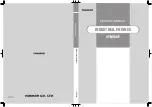
10
430
MAX
CONTROLS
1. PTO LEVER
The PTO lever controls the front drive belt (Power
Take Off or PTO) that supplies power to attachments.
Rotate the lever upward to disengage the PTO and
stop an attachment. Rotate the lever downward to
engage the PTO and start the attachment.
–
Disengage the PTO whenever you stop or leave
the operator’s position.
–
Shut of the engine with the key before making
adjustments or unplugging a clogged attachment.
–
Do no engage the PTO until you are ready to
start operating the attachment
.
2. KEYSWITCH
Gasoline engines:
The key switch has three
positions OFF, RUN, and START. Insert the key and
turn it clockwise to move the switch from OFF to
RUN. Turn it further to START and hold to engage
the starter. Release the key and the switch will return
to RUN from START. Turn the key counterclockwise
to OFF to stop the engine.
Diesel Engines:
The key switch has four positions
PREHEAT, OFF, RUN, and START. Insert the key
and turn it counterclockwise to move the switch from
OFF to PREHEAT until the glow plug indicator lights.
Release the key and the switch will return to OFF.
Turn the key clockwise to move the switch from OFF
to RUN. Turn it further to START and hold to engage
the starter. Release the key and the switch will return
to RUN from START. Turn the key counterclockwise
to OFF to stop the engine.
3. THROTTLE LEVER
Move the throttle lever forward to increase engine
speed until the maximum governed engine rpm
is reached. Move the lever rearward to decrease
engine speed until the engine reaches its idle speed.
4. LIGHT SWITCH
Rock the switch forward to turn the lights on. Rock it
rearward to turn the lights off.
5. WATER TEMPERATURE GAUGE
Water cooled engines only. Displays engine coolant
temperature.
6. VOLTMETER
Displays electrical system voltage.
7. TACHOMETER AND HOUR METER
Displays engine rpm and accumulated engine
operating hours.
8. FUEL GAUGE
Displays fuel level in fuel tank.
9. AUXILIARY HYDRAULIC LEVER
Controls flow of hydraulic oil to hydraulic device
connected to auxiliary hydraulic couplers. This
allows extension or retraction of a hydraulic cylinder,
or rotation of a hydraulic motor. There are four
positions; HOLD, RAISE, LOWER, and FLOAT.
Moving the lever forward from the hold positions
lowers the attachment, moving it farther forward
locks the lever into the detented FLOAT position that
allows a cylinder to float or follow terrain. To raise an
attachment move the lever to the rear to the RAISE
position. If a function performs the opposite direction
of what is intended, reverse the hoses connected to
the auxiliary ports.
10. HYDRAULIC FRONT LIFT LEVER
Controls the vertical position of the front attachment
hitch. There are four lever positions; HOLD, LOWER,
FLOAT, and RAISE. Moving the lever forward from
the hold positions lowers the attachment, moving
it farther forward locks the lever into the detented
FLOAT position. Mower decks should be run in this
position as it allows the deck to follow terrain. For
attachments where down pressure is desired, do not
move the lever into the FLOAT position. To raise an
attachment move the lever to the rear to the RAISE
position.













































